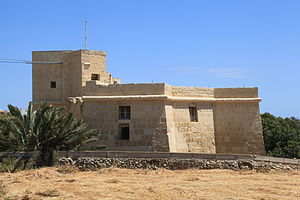
Naxxar is a town and local council in the Northern Region of Malta. The population in March 2014 was 14,891. The Naxxar Church is dedicated to Our Lady of Victories. The annual village feast is celebrated on 8 September. It formerly hosted the Maltese International Trade Fair at Maltese International Trade Fair Grounds.

Saint Thomas Tower, also known as Fort Saint Thomas, is a large bastioned watchtower in Marsaskala, Malta. It was built in 1614, the third of six Wignacourt towers. An artillery battery was added to the tower in the early 18th century. Saint Thomas Tower holds the record as the largest watchtower in Malta.

Għallis Tower, originally known as Torre delle Saline, is a small watchtower in Salina, limits of Naxxar, Malta. It was completed in 1658 as the second of the De Redin towers. Today, the tower is in fair condition.

Qawra Tower, also known as Qawra Point Tower or Fra Ben Tower, is a small watchtower in Qawra, limits of St. Paul's Bay, Malta. It was completed in 1638 as the fourth of the Lascaris towers. An artillery battery was built around the tower in 1715. Today, the tower and battery are a restaurant.

Wignacourt Tower, also known as Saint Paul's Bay Tower, is a bastioned watchtower in St. Paul's Bay, Malta. It was the first of six Wignacourt towers to be built, and the first stone was laid on 10 February 1610. It replaced the role of Ta' Tabibu farmhouse which was previously known as Dejma Tower. An artillery battery was added a century later in 1715. Today the tower is a museum of fortifications around the Maltese Islands.

Saint Mark's Tower, originally known as Torre del Cortin and also known as Qalet Marku Tower, is a small watchtower in Baħar iċ-Ċagħaq, limits of Naxxar, Malta. It was completed in 1658 as the third of the De Redin towers. Today, the tower is in good condition.

Saint Agatha's Tower, also known as the Red Tower, Mellieħa Tower or Fort Saint Agatha, is a large bastioned watchtower in Mellieħa, Malta. It was built between 1647 and 1649, as the sixth of the Lascaris towers. The tower's design is completely different from the rest of the Lascaris towers, but it is similar to the earlier Wignacourt towers. St. Agatha's Tower was the last large-bastioned tower to be built in Malta.

Marsaskala, sometimes written as Marsascala is a seaside town in the South Eastern Region of Malta. Originally a fishing village, it has grown into a tourist destination and a permanent hometown for an ever-growing population.
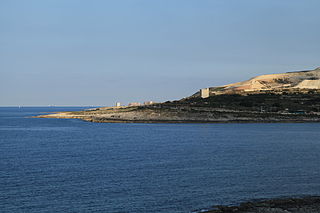
The De Redin Towers are a series of small coastal watchtowers built in Malta by the Order of Saint John between 1658 and 1659. Thirteen towers were built around the coast of mainland Malta to act as watchtowers. Eight of the towers still survive.

Santa Maria delle Grazie Tower, also known as Delle Grazie Tower, Madonna delle Gratie Tower or Blata Bajda Tower, was a watchtower in what is now Xgħajra, Malta. It was constructed in 1620, and was the last of six Wignacourt towers to be built. The tower was demolished in the late 19th century by the British military.

Din l-Art Ħelwa is a non-governmental and non-profit, voluntary organisation founded in 1965 by Maltese Judge Maurice Caruana Curran to safeguard Malta's cultural heritage and natural environment. Since its foundation, Din l-Art Ħelwa has restored numerous cultural sites of historic and environmental importance and currently has the guardianship of a number of them. Many of the sites are open to visitors and for events, thanks to an army of dedicated volunteers. The organisation promotes the preservation and protection of historic buildings and monuments, the character of Malta's towns and villages, and places of natural beauty. It is very active in campaigning against proposed construction which infringes planning laws or policies, and regularly objects to planning applications, taking legal action to halt development in some cases. The NGO stimulates the enforcement of existing laws and the enactment of new ones for the protection of Malta's natural and built heritage.

Saint Mary's Tower, also known as the Comino Tower, is a large bastioned watchtower on the island of Comino in Malta. It was built in 1618, the fifth of six Wignacourt towers. The tower was used by the Armed Forces of Malta until 2002, and it is now in the hands of Din l-Art Ħelwa.
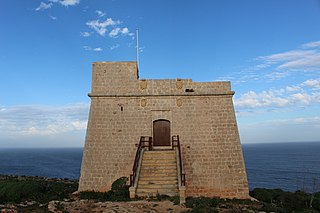
Sopu Tower, also known as Isopu Tower, San Blas Tower or Torre Nuova, is a small watchtower situated on the cliff between San Blas and Daħlet Qorrot in Nadur, Gozo, Malta.

Dwejra Tower is a small watchtower in Dwejra Bay, San Lawrenz, which is on the island of Gozo in Malta. It was completed in 1652, and is part of the Lascaris towers. It is in good condition and is open to the public.

Sciuta Tower, also known as Sciutu Tower or Wied iż-Żurrieq Tower, is a small watchtower in Qrendi, Malta. It was completed in 1638 as the fifth of the Lascaris towers. The tower was restored by Din l-Art Ħelwa.
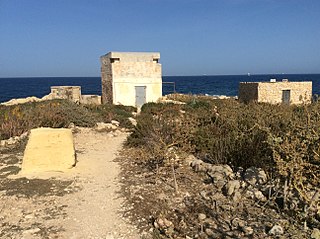
Żonqor Tower, originally known as Torre di Zoncol, was a small watchtower near Żonqor Point, within the limits of the seaside town of Marsaskala, Malta. It was built in 1659 as the eleventh of the De Redin towers, on or near the site of a medieval watch post. The tower commanded the entrance to Marsaskala Bay along with Saint Thomas Tower. It was demolished by the British military in 1915 to clear the line of fire of modern fortifications.

The fortifications of Malta consist of a number of walled cities, citadels, forts, towers, batteries, redoubts, entrenchments and pillboxes. The fortifications were built over hundreds of years, from around 1450 BC to the mid-20th century, and they are a result of the Maltese islands' strategic position and natural harbours, which have made them very desirable for various powers.

Vendôme Tower is a tour-reduit in Marsaxlokk, Malta. It was built by the Order of Saint John in 1715 as one of a series of fortifications around the coasts of the Maltese Islands. It is the only surviving tour-reduit in Malta. Today, Vendôme Tower houses the headquarters of Marsaxlokk F.C.
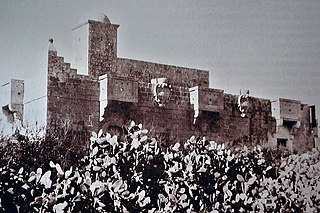
Gourgion Tower was a fortified house in the outskirts of Xewkija, Gozo, Malta. The tower was built by Giovanni Gourgion in 1690, and it became a symbol of the village of Xewkija. Despite being listed on the Antiquities List in 1925, it was demolished by American forces in 1943 to make way for an airfield for the Allied invasion of Sicily.

Bubaqra Tower, formerly named as Saliba Tower, is a fortified house in Bubaqra, limits of Żurrieq, Malta. It was built as a country retreat in the late 16th century. The tower and its gardens have been restored, and now serve as a family retreat. Officially named as Bubaqra Palace, it is a grade 2 national monument.
